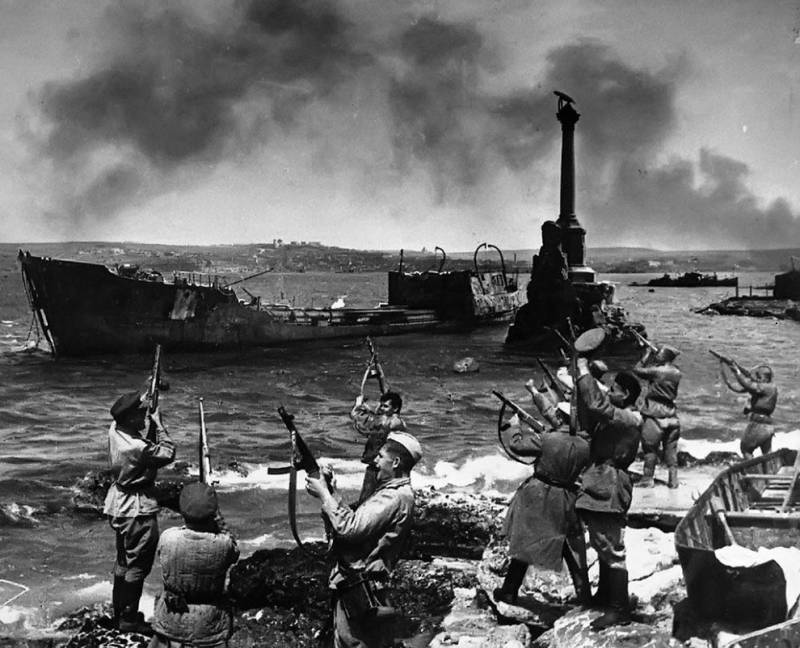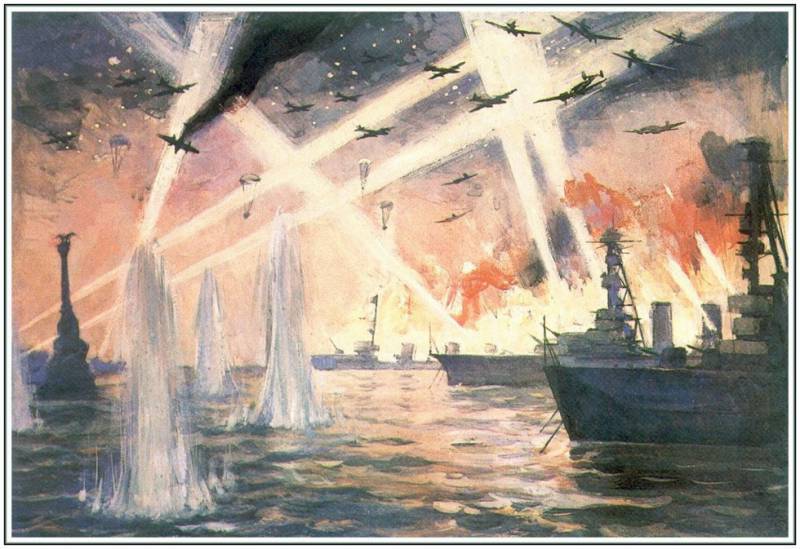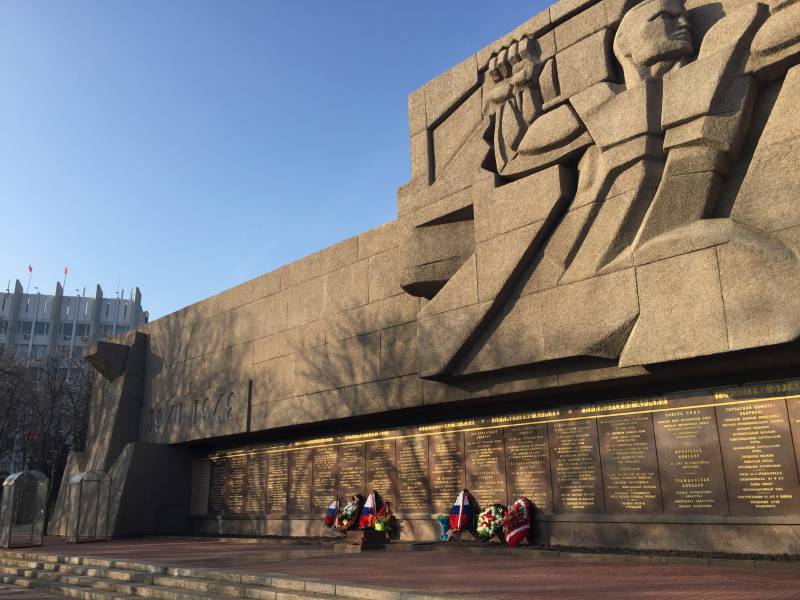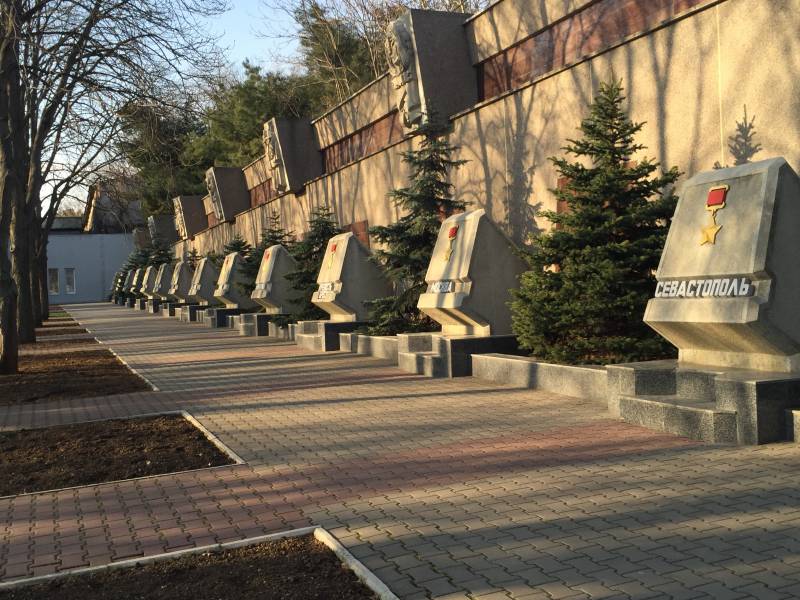Defense of Sevastopol: 1941 – 1944
“In response to a double raid on Sevastopol by German bombers from the territory of Romania, Soviet bombers three times bombarded Constanza and Sulin. Constance is on ”[1].
And two days later, 26 Jun:
"Our aviation Bucharest, Ploiesti and Constanta bombarded during the day. Refineries in the Ploiesti region are on fire ”[2].
“SOVIET AIR TRAINER ATTACKING GERMAN OIL”
And it is true! In those terrible days, it was from the Crimea, from Sevastopol, that the news came that encouraged the whole country, became the first signs of future victories, not yet quick victories. The details were not known to everyone. The editor-in-chief of the front newspaper Krasny Chernomorets, Pavel Musyakov, in his diary, reveals them. It turns out that not only aircraft, but also the Black Sea Fleet participated in the retaliatory strike against the enemy:
“Yesterday the ships returned from the operation to bombard Constanza from the sea. Hundreds of shells were sent around the city, port and oil tanks. The black smoke of the oil fires has long stood on the horizon when our ships were already tens of miles from the Romanian shores ”[3].
During a dangerous raid on the enemy shore on one of our ships, pipes in two boilers burst. There was no time to cool the hot furnace. And then the boiler drivers, Kaprov and Grebennikov, put on asbestos suits, wrapped their heads in wet bandages, and worked for half an hour in a real heat, removed the faulty pipes, and muffled them into the nests. They lose consciousness several times, they are pulled out, they are poured with water, they bring to life a “encouraging liquid”, they allow them to breathe ... And again - into the furnace, armed with hammers and chisels. Finally, the malfunction has been resolved, and our leader is at full speed going to his native harbor [4].
And on the same days, amazing rumors spread to the capital at lightning speed: “The Red Army bombed out and took Warsaw, Königsberg and leads a successful offensive against Romania,” and “Ribbentrop shot himself” [5] ...
... Hitler was going to take Sevastopol in the summer of 1941 of the year. However, this Black Sea blitzkrieg was also disrupted by heroes of Sevastopol, who held the enemy here for a long eight months. The defense of the city lasted 250 days - from October 30 1941 of the year to July 4 of the year 1942.
Then, in 1941, the resilience of the defenders of Sevastopol, who had withdrawn significant enemy forces to themselves, contributed to the defeat of the German troops near Moscow. Heinz Guderian recalls Adolf Hitler's order from 21 August 1941:
“Before the onset of winter, the most important goal is to consider not the seizure of Moscow, but the seizure of the Crimea ...” But the “city of Russian sailors” continued to defend itself, even being in the ring of enemies. They say that at the same time the Fuhrer called the Crimea "unsinkable Soviet aircraft carrier attacking German oil ..."
Yes, now it is German, and not at all Romanian ...
“FOREVER STAY ALIVE”
In order for the huge warring country to live not by rumors, but by true information from the battlefields, hundreds of “fighters of the cultural front” went to the front. And very soon in the front-line edition of the “Red Black Sea” appeared “brothers-writers”, journalists, artists sent to create historical Chronicle of heroic resistance of Crimeans to the enemy. Not ready for the harsh military weekdays, “deeply civilians” at first they seemed to chief editor Musyakov, who silently called them “bespectacled”.
Although it soon became clear that they were desperate brave men, and it seemed more than others in those harsh days who believed in our future Victory.
Writers Peter Gavrilov (the author of the wonderful story for children “Egorka” - about a bear cub making friends with sailors), Vasily Ryakhovsky (author of the historical novels “The Native Side” and “Evpaty Kolovrat”), Ignat Ivich (the author of popular science books for children) and Augustus Yavich, who after the war will create his "Sevastopol Tale". Poet Lev Dligach, known for his children's poems, and satirist-poet Jan Sashin. Artists Fyodor Reshetnikov (the future author of the famous paintings “Again deuce”, “Arrived on holidays”, “Got a tongue!”, “For peace!”) And Leonid Soyfertis (the author of vivid cartoons for the magazine “Crocodile”.
... Combat operations, heroic deeds, examples of the inflexible will of Sevastopol and their front-line life, touching in its simplicity, became the main themes of the reporting by cameramen: Dmitry Rymarev, Fyodor Korotkevich, Abram Krichevsky, G. Donets, Alexander Smolka, Vladislav Mikosha. And more than once they heard words full of hope during the battles from the heroes of their kinococki:
“Brothers, we are filmed. We will remain alive forever "...
Indeed, how many relatives and friends saw them on the screen ... still alive and young.
Two documentaries that the whole country watched were shot in Sevastopol by director Vasily Belyaev during the war years. During the defense of the city (1942 year) - "Chernomorets", in the days of his liberation (1944 year) - "Battle of Sevastopol."
“The enemy brings down tons of metal, he destroys magnificent buildings - houses, scientific institutes, temples, monuments of art ... But the bombing ended, the shelling calmed down, and boulevards and streets came to life again. A young mother rolls a child in a stroller, a fighter brings shine to the boots of a street sweeper.
The guys march in step with a detachment of sailors going to the front and with inexpressible pride flaunt themselves in their sea-bound coat jackets and beskozyrkah.
... In the ruins of Inkerman, located near the Sevastopol ruins of the ancient cave city, under the natural shelter of rocks and stone piles, there is intense work of defense factories located there, bakeries, hospitals. There forges weapon of the struggle and victory, the wounded are brought there, and in the underground hospitals they are operated and nursed ”[6], the film“ Chernomorets ”transmitted the atmosphere of the belligerent city.
“AND HOUSEHOLD AND POETRY” IN THE OBJECT OF V. MIKOSHI
In the days of especially fierce raids, the operator Vladislav Mikosha, while on a boat, removes the Soviet destroyer from a distance of 40 – 50. The boat turns around helplessly, and before 70, enemy bombers swoop on an already burning destroyer. Our sailors continue to shoot from anti-aircraft guns, even when the clothes on them caught fire and even when the ship began to sink, and the water reached them to the waist. The last shots: above the water you can see the nose of the destroyer and the punched flag ...
And, perhaps, it is no coincidence that the fearless special correspondent of Pravda with the “gentle” name of Mikosha, derived from Mikolai, Nikolai, wrote many chronic pages in the chronicle of the defense of Sevastopol, since the saint bearing this name has long been considered the patron saint of sailors.
Father Vladislav Vladislavovich Mikoshi was the captain of the long voyage. Maritime gave manili and his son, who was born and raised in Saratov, a ten-year-old kid swimming across a great river, who was fond of air acrobatics, painting, music, and cinema. He even mastered the craft of projectionist. And Volzhanin decided to enter in 1927 year, nevertheless, in the Leningrad Navigation Ship. But he didn’t go through the medical commission, because, to his chagrin, he had caught a bad cold the day before.
He returned to his native Saratov, where his former position in the Iskra cinema was waiting for him. Two years later, Vladislav became a student of the State Technological College in Moscow (now the All-Russian State Institute of Cinematography), who graduated in 1934 year. It was he who shot the explosion of the Cathedral of Christ the Savior and the opening of the All-Union Agricultural Exhibition (VDNH), the epic of salvation for the Chelyuskinites and the flights of Valery Chkalov and Mikhail Gromov to America, visits to Moscow of world celebrities: Bernard Shaw, Romain Rolland, Anri Barbus. Sent to the Black Sea Fleet, he was finally able to put on a black sea uniform and removed the defenses of Odessa, Sevastopol, and then defeated Berlin.
The director of the epic “Great Patriotic War” Lev Danilov wrote:
“It’s fair to say about the military filming of Mikoshi that they are both life and poetry right away ... There is always an event temperature on the film film filmed by Mikosha”.
L. SOYPHERTIS AND “THE STUDY APPROACH”
All the long Sevastopol days and months of the “temperature of the event” in the city remained red hot, and this heat is noticeable not only in newsreel footage, but also in front-line sketches by artist Leonid Soyfertis.
In the 36 No. 1944 for the year, the magazine Crocodile published the Sevastopol Album of its permanent author, the artist Leonid Soyfertis. A native of the town of Ilintsy, Vinnitsa County, Podolsk Province, so far from the sea, by the will of fate, he praised the sailors of Odessa, Sevastopol, Novorossiysk in his work. The cartoonist, who arrived from the capital on the Black Sea Fleet in the early days of the war, painted cartoons on the topic of the day for the newspaper Krasny Chernomorets, although the daily life of the heroic city provided so much food for creative thinking that the artist soon discovered the new genre.
Later, experts will note in his sketches of the times of the defense of Sevastopol a special approach to resolving the topic - the “storytelling approach”. And they told the viewer "with a thoughtful perception ... of the nationwide war, of that ardent love that surrounded the country with its heroic Army and Navy" [7]. They noted the critics and the special “ability to recognize in a small, as if random, even a ridiculous episode, a great, magnificent time” [8] ...
In the graphic pictures of Soifertis depicting the life of war, there is not a single one killed and no one shoots, and people shown in everyday situations do not even seem to feel like heroes.
The artist himself was surprised by this habitual heroism. The nurse girl dressed for 8 Martha's celebration in a red guipure dress with a white bow:
"She came in her overcoat, and she had a spoon behind her boot, and the leading positions were very close, and where she holds a suitcase with a dress there - only God knows" [9].
“In Sevastopol,” the artist recalled, “I lived in the center of the city, but it was enough to leave home to feel at the front. I was struck by the continuity of life that persisted everywhere, despite the horror of incessant bombing and incessant battles. I remember, at the airport I saw a pilot who was shaving before a sortie with the composure of a man who was confident of returning.
Or such a detail: in the trench next to the mortar is a balalaika. I remember the postman, who was delivering letters, making his way through the just-destroyed building to the bomb shelter; she knew what bomb shelter her addressee was in. I was given the confidence of everyone to win, and I wanted to talk about what I see, optimistically, cheerfully ”[10].
In the picture "Once" - two boys, shoeshine cleaners, on the move, clean their shoes to the brave sailor. He spread his legs wide and leaned his hand on the theatrical stand - in a hurry to fight! Another sailor froze in front of the photographer's camera, right in the bomb crater, among the ruins, - “Photograph for the party document”. And the third sailor in mighty hands, who might have strangled the enemy just a minute ago, is carefully holding the kitten - “Found the kitten”!
The little girl is famously and merrily working with brooms, sweeping the stairs, except that she does not lead to the house, and in the empty doorway there is the sky - “Cleaning the stairs”. In another picture, the kids sit on the hedge and watch the sailors' squad pass by, and above their heads, just like that, in a row, the swallows sit on the wire - “The Sailors Are Going” ...
A few subtle touches - and the sketches are filled with air, movement, the sun, hope ...
The commander of the unit in which L. Soifertis was in the newspaper Literature and Art told about the same ordinary heroism of the artist himself. It turns out that he was lying next to a gunner sailor under German fire in order to capture “what is a person’s facial expression when he shoots at fascists” [11].
DASH SHOT ON FLAG STOCK
... And yet, despite the massive heroism of Sevastopol, the city after the appearance of German long-range cannons on the mountains, which changed the balance of power, had to leave 1942 in July. It is difficult, scary, with very large losses. Recall that at this time the Germans were standing at the walls of Stalingrad, on the outskirts of the oil regions of the Caucasus.
... From April 8 to May 12, 1944, the troops of the 4th Ukrainian Front and Separate Primorye Army in cooperation with the Black Sea fleet and the Azov military flotilla carried out an operation to liberate the Crimea, which began with a brave landing of the Separate Maritime Army on the Kerch Peninsula.
The liberation by our troops of the largest cities of the Crimea: Theodosia, Yevpatoria, Simferopol was swift. And with a powerful wave they roll on Sevastopol. Three lanes of iron and concrete, combined into powerful resistance nodes with an extensive system of anti-tank and anti-personnel barriers, surrounded the city. Sapun-gora is the dominant height, with steep slopes encased in reinforced concrete with a four-tier system of trenches, enmeshed in engineering structures.
The assault began on May 7 with strikes from our bomber aircraft. Then came the artillery, which destroyed the pillboxes on the mountain slopes. Fighters of assault groups with anti-tank guns went into battle, they were carrying guns along the mountain slopes and were beating the embrasures. Behind them the infantry rose to the top of the mountain ...
... Among the advanced units that broke into Sevastopol, there were also cameramen: Vladislav Mikosha, David Sholomovich, Ilya Arons, Vsevolod Afanasyev, G. Donets, Daniil Kaspiy, Vladimir Kilosanidze, Leonid Kotlyarenko, Fyodor Ovsyannikov, Nikita Petrosov, Mikhail Poychenko, Aleksandr, Viktor Vladimir Sushchinsky, George Khnkoyan and others. Films of fights shot by them and will be included in the film “Battle for Sevastopol”.
From the top of the mountain, on which the old Italian cemetery is located, cameraman Mikosha shoots tank the battle in the Inkerman Valley, he sees German ships hurrying off into the sea. And on the Count's wharf, for lack of a red flag, Red Navy sailors tie a stripped vest and visor to their flagpole.
These shots will be a spectacular ending of the film, accompanied by voice-overs: "Where the Germans took two hundred and fifty days at the beginning of the war to overcome the defenses of Soviet soldiers, the Red Army there broke the German resistance in five days."
SO MISCELLANEOUS SOURCE OF WAR
... The war left us, researchers, a variety of source material, and this is not only archival documents and eyewitnesses. It is also footage newsreel, front-line newspapers, sketches of artists, and even ...
... My senior colleague - Doctor of Historical Sciences, Professor Mansur Mukhamedzhanov - served in Sevastopol for military service in 1955 – 1959. It seemed that the hero-city had already completely healed its battle wounds. But once in the mountains at the exercises, young sailors, digging in, found a lead strip, twisted like an ancient script, unfolded and read:
"We stand here until the end!"
And - a short list of names ...
An unexpected find was handed over to the museum, and the post-war generation of sailors with a special sense of belonging to the heroic defenders of the city sang with the whole system, marching to the Lunacharsky Theater, a front-line song by an unknown author, far from the literary perfection of generations:
With the Black - I, you - from afar,
You came from the Far East.
We are two of you
Hard Germans beat,
Defending the city of Sevastopol.
Waiting for us ahead of heavy fighting.
There is still a lot of battle ahead.
Russian was and is
Sevastopol is ours.
Sevastopol - the city of Black Sea!
... The most instructive and touching for us, the descendants, is the attitude of the survivors to the memory of the fallen. Already on October 17, 1944, on Sapun Mountain, opened a obelisk monument to Soviet soldiers who fell in battles for the liberation of the city.
NOTES
[1] Sovinformbureau. Operational summaries for 1941 year. [Electronic resource] // Great Patriotic War http://1941-1945.at.ua/forum/29-291-1 (appeal date: 07.03.2016).
[2] Ibid.
[3] P. P. Musyakov Sevastopol Days // Moscow-Crimea: Historical and Publicistic Almanac. Special Issue: Crimea in the Great Patriotic War: diaries, memories, research. Issue 5. M., 2003. C. 19.
[4] See ibid.
[5] RGASPI, F. 17, Op. 125, D. 44.
[6] V. Smirnov. Documentary films about the Great Patriotic War. M., 1947. C. 39.
[7] Fine art in the years of World War II. M., 1951. C. 49 – 51.
[8] Ibid. S. 80.
[9] Ibid.
[10] Ibid. S. 117-118.
[11] Ibid. S. 80.




Information